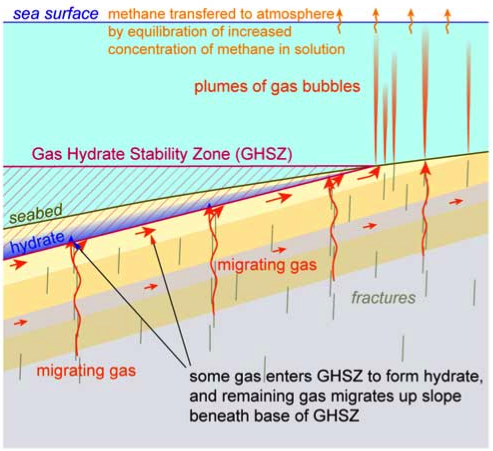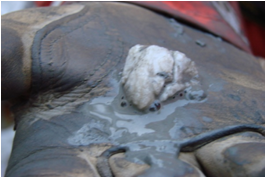A new collaboration between the National Oceanography Centre (NOC) and the University of Southampton is seeking to improve geophysical remote sensing of seafloor methane gas and hydrate through innovative laboratory experimental and theoretical studies.
Researchers will develop a new laboratory instrument capable of simulating the high pressures and low temperatures needed to create methane hydrate in sediment samples and carry out acoustic and electrical properties experiments. The results will be used to develop theory for modelling geophysical survey data in terms of seafloor gas and hydrate content.
Dr Angus Best of NOC and Professors Tim Leighton and Paul White from the University of Southampton’s Institute of Sound and Vibration Research (ISVR) have been awarded a grant of £0,8 million by the Natural Environment Research Council (NERC) to investigate methods for assessing the volume of methane gas and gas hydrate locked in seafloor sediments.
Dr Best, who is leading the project, explained “Natural methane, a greenhouse gas, is trapped in sediments beneath the seafloor on continental shelves and slopes around the world, sometimes as methane hydrate – a solid, ice-like material. Currently, there are only very broad estimates of the amount of seafloor methane and hydrate. Improvements to geophysical remote sensing methods, especially acoustic methods, offer a way to better assess this important store of greenhouse gas.”
Apart from the possible impact on ocean acidification and global warming if seafloor methane were released in to the water column or atmosphere, methane hydrates are a potentially important energy resource. This week it was announced that for the first time, natural gas has been extracted from frozen methane hydrate in a pilot production project off the Japanese coastline, and other countries are also exploring options for exploiting this energy resource. Methane hydrates may also contribute to geo-hazards such as seafloor landslides – it is thought that earthquakes and the release of gas hydrates caused the largest-ever landslide, the Storegga Slide, around 8,000 years ago.
The team plan a series of experiments on a range of sediment types, such as sand and mud. They intend to map out the acoustic and electrical properties of differing amounts of free methane gas and frozen solid methane hydrate.
The laboratory-based approach adopted by the team will involve the development of a major new Acoustic Pulse Tube instrument at NOC. Using acoustic techniques and theories developed by the ISVR team, they aim to provide improved geophysical remote sensing capabilities for better quantification of seafloor gas and hydrate deposits in the ocean floor.

“Not much is known about the state of gas morphology – bubbles. Muddy sediments show crack-like bubbles, while sandy sediments show spherical bubbles. Only dedicated lab experiments can hope to unravel the complex interactions. By creating our own ‘cores’ of sediment material in a controlled environment where we know the concentrations of methane, we can create models to help us with in situ measurements on the seafloor.”
Professor Leighton said “The three of us have collaborated in recent years in an experiment that used acoustics to take preliminary measurements of gas in the muddy sediments revealed at low tide. Those measurements, and the acoustic theory we developed to interpret the data, provided exactly the foundation we needed to undertake this critically important study that will be relevant to the seabed in somewhat deeper waters.
“As a greenhouse gas, methane is 20 times more potent per molecule than carbon dioxide. There is the potential for climate change to alter sea temperatures and cause more methane gas to be released from seabed hydrates into bubbles which reach the atmosphere. It is therefore vital that we have the tools to quantify and map the amount of methane that is down there.”

